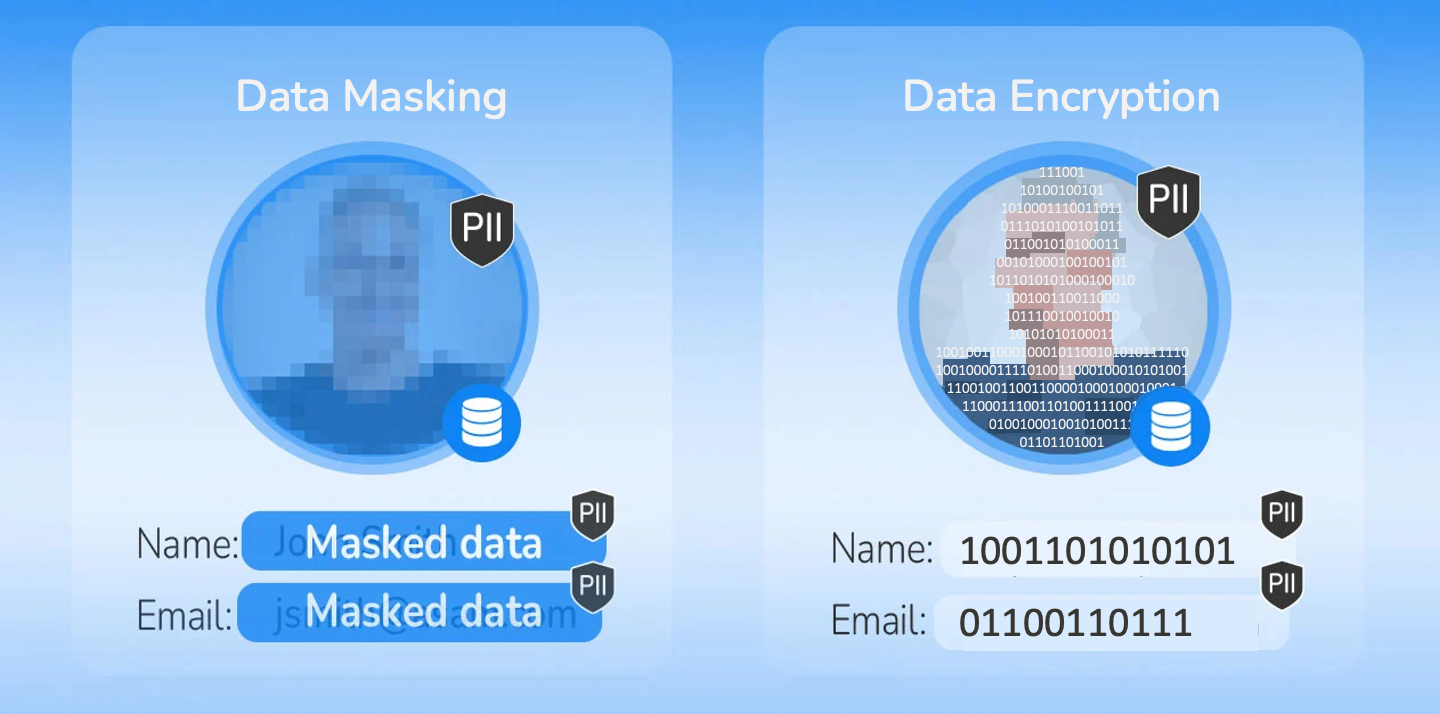Here’s a rundown on data masking vs encryption vis a vis how they both work, what they’re used for, and how to pick the best solution for your business.
Table of Contents
Data Masking Does Not Equal Data Encryption
What is Data Masking?
What is Data Encryption?
Types of Data Masking
Types of Data Encryption
Data Masking vs Encryption: 2 Key Differences
Data Masking Use Cases
Data Encryption Use Cases
With a Data Product Platform, You Don’t Have to Choose
Data masking is not data encryption
Data privacy and governance stewards, tasked with choosing the right data anonymization solution for their organization, often have the same questions:
Data masking vs encryption: Which is best for a certain repository? Does the business need both?
While encryption and data masking techniques have some similarities, they are technically two separate approaches to data privacy management. Understanding both solutions is critical to making the right choice for protecting sensitive data, and remaining compliant with strict data protection laws like GDPR and CCPA.
In this article, we’ll cover the definitions and different types of data masking and encryption, when to use each, and how data products are changing the rules of the game.
The meaning of data masking
Data masking is a process of data obfuscation that involves replacing real, sensitive data with scrambled, yet statistically equivalent, data. Masked data can’t be identified or reverse-engineered, but it is still functional. This means it can still be used for software testing and data science.
Efficient data masking tools assure usability and referential integrity across multiple databases and analytics platforms – statically, and dynamically.
The meaning of data encryption
Data encryption is another common form of data obfuscation. It involves converting readable plaintext into incomprehensible, randomized text, called ciphertext. The process of encrypting data involves the use of a mathematical algorithm that acts as a cryptographic key.
The original data remains within the new code, which means it can be decrypted with the appropriate key. Authorized users with access to the key can view the original, plaintext data. Encrypted data is potentially vulnerable to data breaches, for example, by social engineering or hacking.
Types of data masking
- Static data masking
Static data masking techniques are most commonly used to anonymize sensitive data on a backup of a production database, or a “dummy” database. They alter data while maintaining referential and contextual integrity, for use in development, testing, and training. - Dynamic data masking
Dynamic data masking transforms sensitive data in real time, to enable role-based security. When a user queries data, the data streams from a database or production environment are masked on-the-fly, depending on roles and permissions.
Types of data encryption
-
Symmetric encryption
Also known as private key encryption, symmetric encryption relies on the same key to both encode and decode encrypted data. This type of encryption is best suited for individual users and closed systems. The main risk associated with symmetric encryption is the interception of the key by an unauthorized user, such as a hacker. -
Asymmetric encryption
This type of encryption uses a public and a private key that are mathematically linked. While the private key is kept secret by the data owners, the public key is shared among authorized users.
Two key differences between masking vs encryption
Both data masking and encryption conceal sensitive information and enable organizations to comply with data privacy standards such as GDPR, HIPAA, PCI DSS, and CCPA. The main difference between them is functionality.
Masked data remains usable for development and QA teams in production and testing environments, while encrypted data is challenging to work with.
Another difference is the ability to recover original data values. Masked data cannot be reversed, while encrypted data can be decrypted with the right key.
Data masking use cases
Data masking is a persistent data security solution, meaning it secures data at rest, and in motion. It’s particularly useful for securing PII that has consistent formatting, like credit card, drivers license, or Social Security numbers, while ensuring that the data remains functional.
Data masking best practices call for the following data masking use cases:
-
Credit or debit cards
-
Bank accounts
-
Social Security Numbers
-
Medical records
-
Personally Identifiable Information (PII)
Data encryption use cases
Data encryption secures data by rendering it unreadable, unless it is decrypted with an encryption key. Advanced encryption methods are nearly impossible to break, but this level of security often reduces the data’s functionality.
Given its drawbacks, encryption is most helpful for securing unstructured data at rest, or data that is being transferred between networks. It is ideal for securing PII found within:
- Files
- Videos
- Images
Data tokenization, which can be reversed, is an alternative method for protecting sensitive data. Data tokenization involves substituting sensitive data with a non-sensitive equivalent or “token” for use in databases or internal systems. Like data masking, tokenized data remains functional and usable for development and testing. In most data tokenization software systems, the original data is stored securely in an external, centralized data vault outside of the local IT environment.
No need to choose with a business entity approach
Entity-based data masking technology is ideal for data protection because it includes data masking techniques, data encryption, and data tokenization tools – to ensure data is always secure, whether it’s on the move, or at rest.
A business entity could be customers, payments, orders, or devices. The data for each instance of a business entity is stored and managed in its own Micro-Database™. Each Micro-Database is encrypted with a 256-bit encryption key, eliminating the risk of a mass breach.
The platform masks structured and unstructured data on the fly, while maintaining referential integrity. Images, PDFs, text files, and other formats that contain sensitive information are protected with static and dynamic masking capabilities.
On top of that, an entity-based approach to securing sensitive data enables the use of data tokenization solutions without the security risks associated with storing all original sensitive data in one centralized location. Whereas a centralized data vault could be vulnerable to attack, business entities enable a decentralized approach to tokenization, in which each entity’s sensitive data is tokenized and protected in its own Micro-Database.
Learn how K2view data masking tools
support data masking AND encryption.













